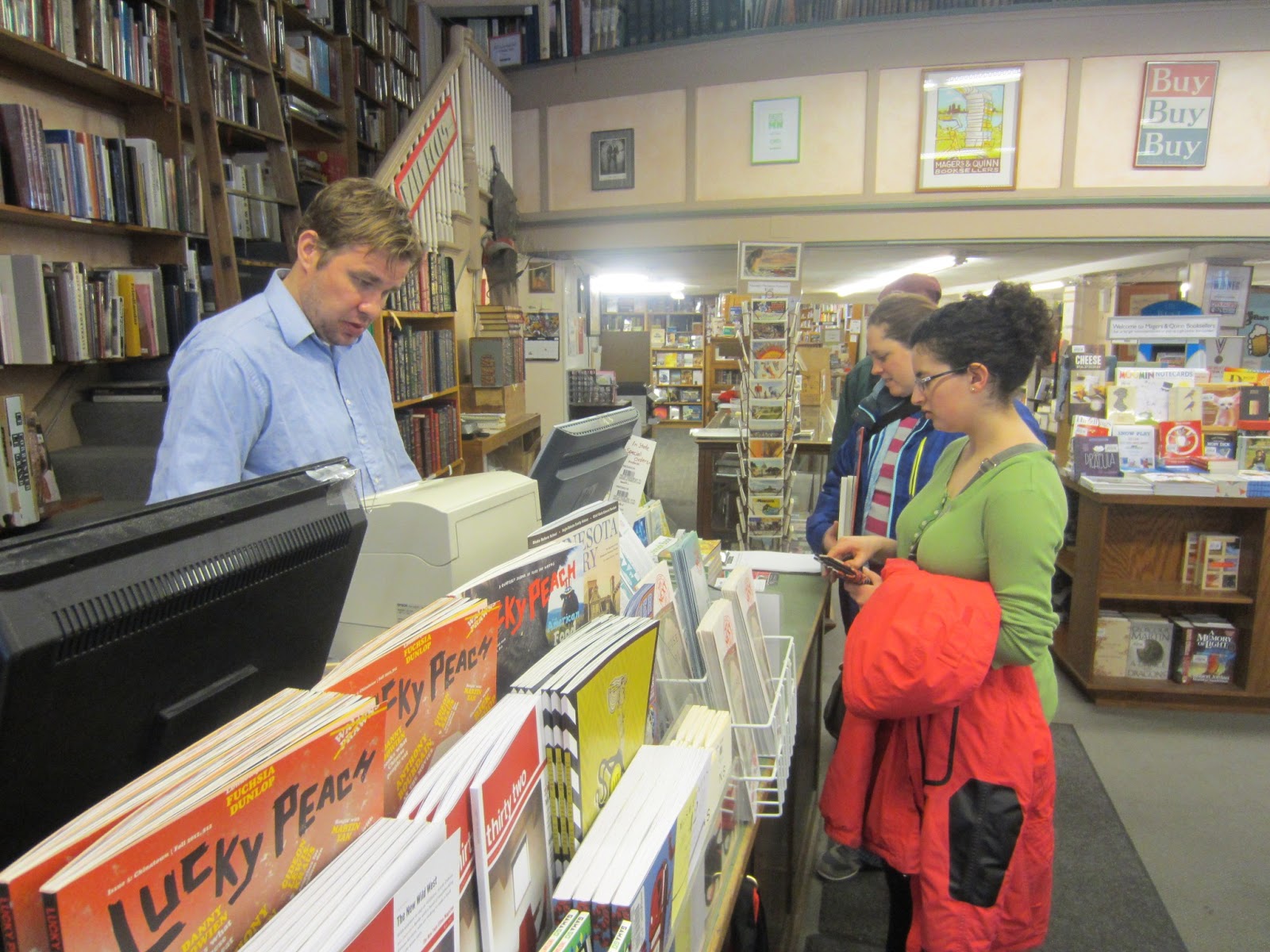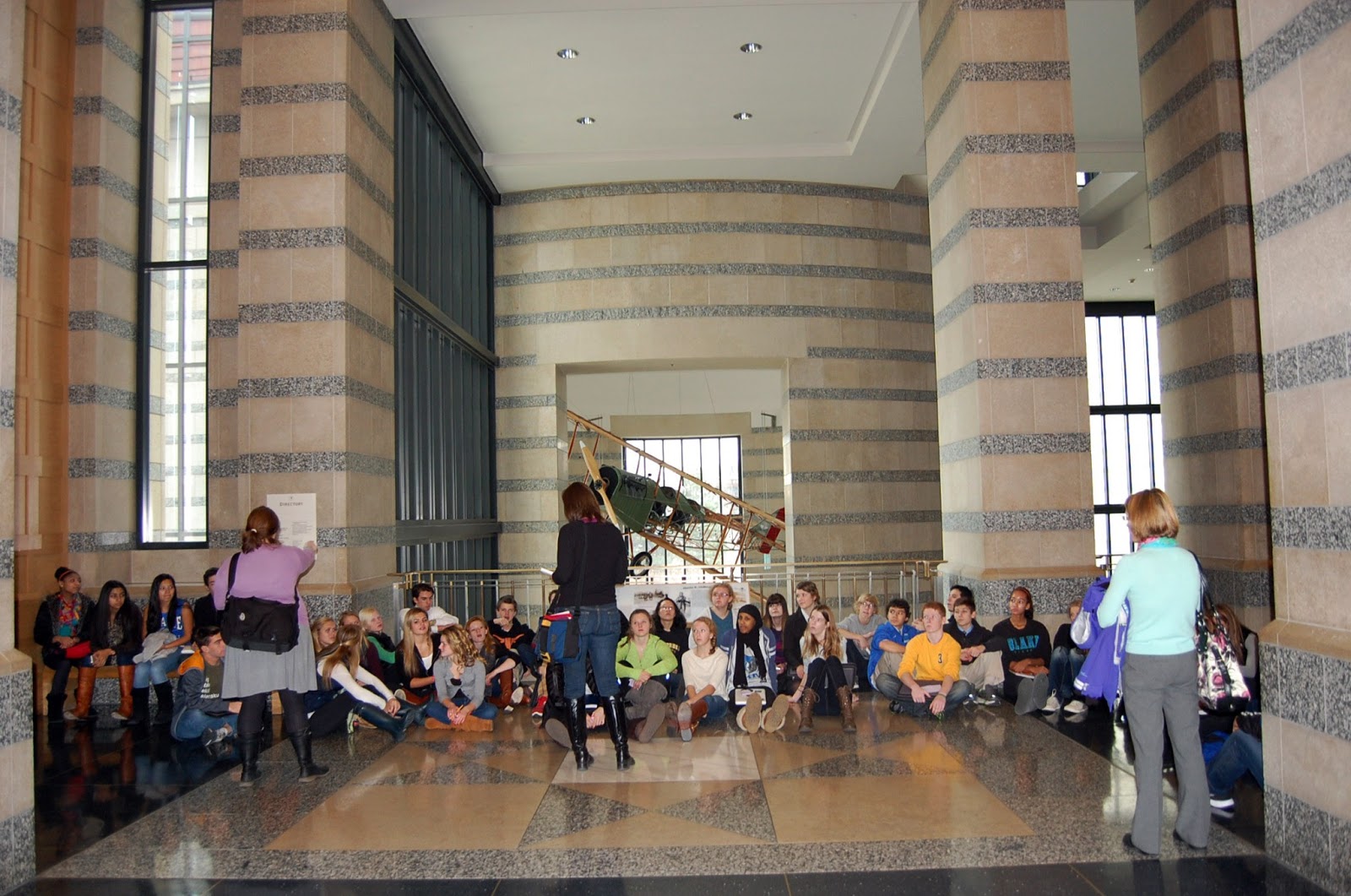Apologies for our long absence! We've been renovation and rebuilding our space to create a brand new library, and it is beautiful.
 |
| The new library reading room; we are particularly fond of the big turquoise chairs. |
In case you forgot, here's what the library has looked like for the last thirty years:
 |
| The old library: lots of dark wood and undefined, poorly used space. |
In redesigning the library, we wanted to take into account how we were using the space, and how we wanted to use the space. The library has always been a popular spot, with classes meeting there and students working in the library all day. But there was no separate space for quiet study. Our reference desk was a glorified desk, with table shoved against it to make it big enough. Our offices were separated from the library in another room, making it hard to observe what was going on in the library and hard to get work done without being interrupted by the many people who would wander through during the day. When multiple classes wanted to use the space, they fought for enough room to work separately, and when they worked together there was little space for anyone else in the library. Originally built in 1980, our thirty-year-old library was simply not able to fully function as the collaborative, common space that is today's school library.
So we wanted a library that did reflect how our teachers and students use the library. Last year, we attempted to create a "classroom" space off to one side by moving and rearranging shelving and tables. In the new design, two actual classrooms were built into the library for that exact purpose.
 |
| The Danielson Room features a glass wall for light and visibility. |
 |
| Whiteboards line the walls of the Danielson Room while our portrait of Abe Lincoln oversees all. |
The Danielson Room (above) is a dedicated library classroom. Two walls of whiteboards, two projectors, and tables and chairs for more than thirty mean we can teach two sections of classes in this space, which is set apart from the rest of the library by a wall of glass doors and windows. During tutorial blocks, this rooms fills our need for quiet study space.
 |
| The media classroom has whiteboards lining the walls, four projectors, and a large screen TV. |
The Melamed Media Studio (above) is a classroom designed for our media arts classes: computer science (new this year!), digital filmmaking, and music technology. The classroom is chock-full of projectors, plus an interactive large-screen TV for presentations from teachers and students.
We also have two study rooms for about five students each. We're not reserving these rooms; they're being used on a "first come first served" basis. The highlight of these study rooms is the whiteboard paint, so students can literally draw on the walls.
 |
| Our two new study rooms, with the giant projector for the Carlson Commons between. |
Our new reference desk is a work of art. Conceived by the architects who designed the new space, the reference desk is multi-tiered with lots of workspace. There's a separate desk for the self-checkout station (complete with fancy book drop slot and cart, ooh la la) and our patrons are meant to walk between the two and interact with us anywhere, anytime.
 |
| Helping students and teachers at the new reference desk. |
 |
| Sean plays with the scanner at the reference desk. |
Since we have a 1:1 laptop program for all our students and staff, the library is also home to tech support for those laptops as well as for projectors, smartboards, and other technology that teachers use in the classroom. The new space has a workroom and a "genius bar" type of desk for our fantastic tech, Gary, to work at and be more present in the space.
 |
| Gary at the new tech bar, with the workroom behind him. |
 |
| Gary repairs a record number of laptops at once. |
 |
| Gary's son visits and shows us to write on the windows. |
We also have a craft table which features, at the moment, our brand new 3D printer (more on that in later post!). We kept the old library card catalogs and use them to store office supplies (one on each side of the craft table)--and to add just a touch of tradition to our new sleek modern library.
 |
| The craft table with the 3D printer; the workroom and our new office are behind. |
And what of the books, you ask? Despite appearances to the contrary, we have all our old books. But the shelf space is considerably more compacted, on new white metal shelves, with room for the collection to grow.
 |
| The new stacks. |
There's also a cozy little reading area tucked behind the shelves, with single desks at the end of each shelf for quiet individual study.
 |
| This little nook behind the stacks has already been adopted by our Library Club. |
The library is on the second floor of this wing of the school; below us, the science wing also underwent a renovation and redesign. The two physics classrooms moved up to join us in the library wing, and the floors are connected by a common space called the Carlson Commons which features an impressive staircase with stadium seating and a giant projector screen.
 |
| The Carlson Commons as seen from the science wing, downstairs below the library. |
 |
| The staircase has become a popular place for students to work and hang out. |
The grand thing about the new library is that our students have been using the space almost exactly as we designed. The lightweight furniture can be moved and rearranged easily for group work and for after-school events. Teachers are reserving the Danielson Room on a daily basis, and the study rooms are almost never empty. The Carlson Commons staircase is the heart of the new space--we've held faculty meetings and grade meetings here, used the space to screen current events like the Nobel Conference, and it's become a popular space for students to work or just hang out.
We really love our pretty new library.




















































